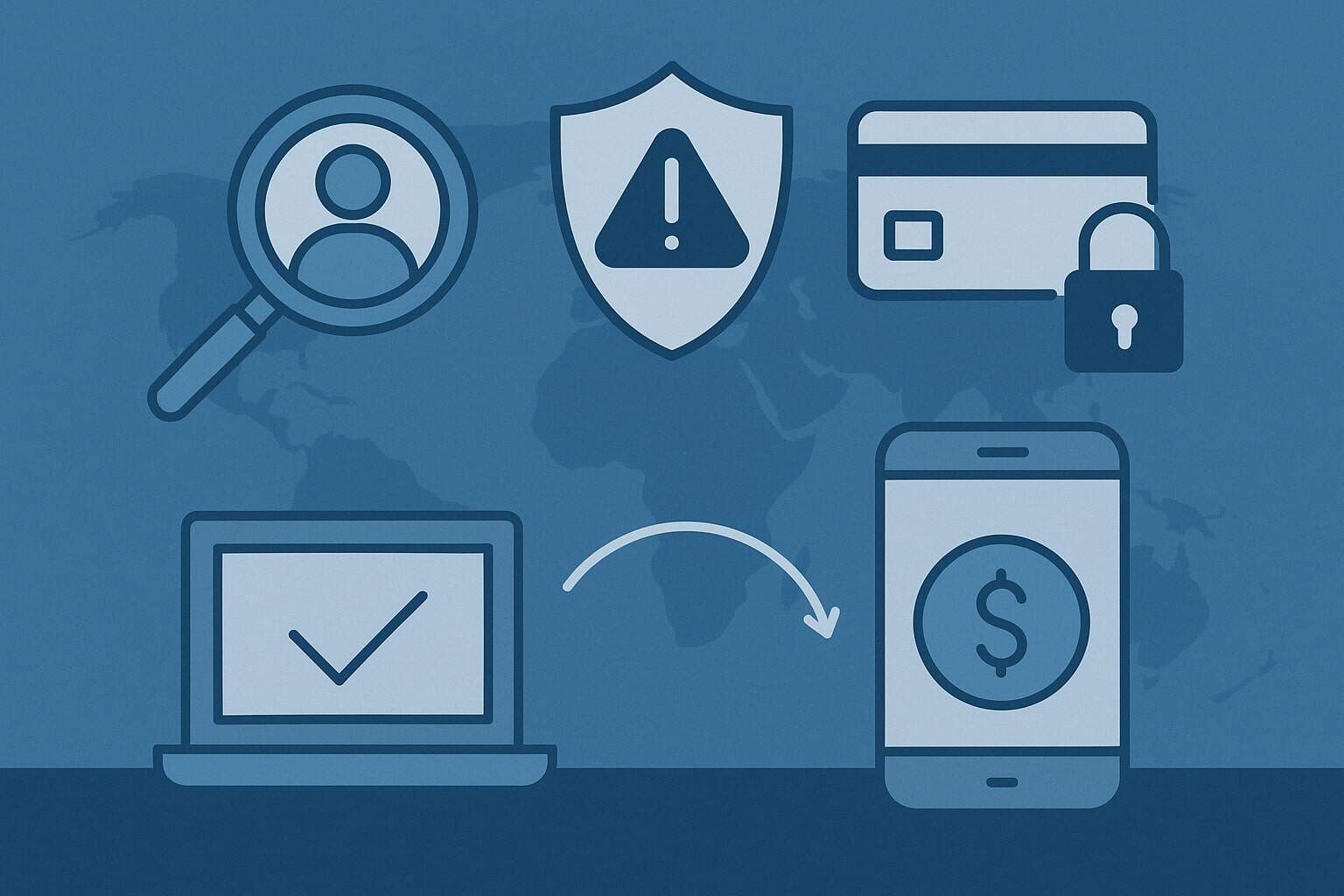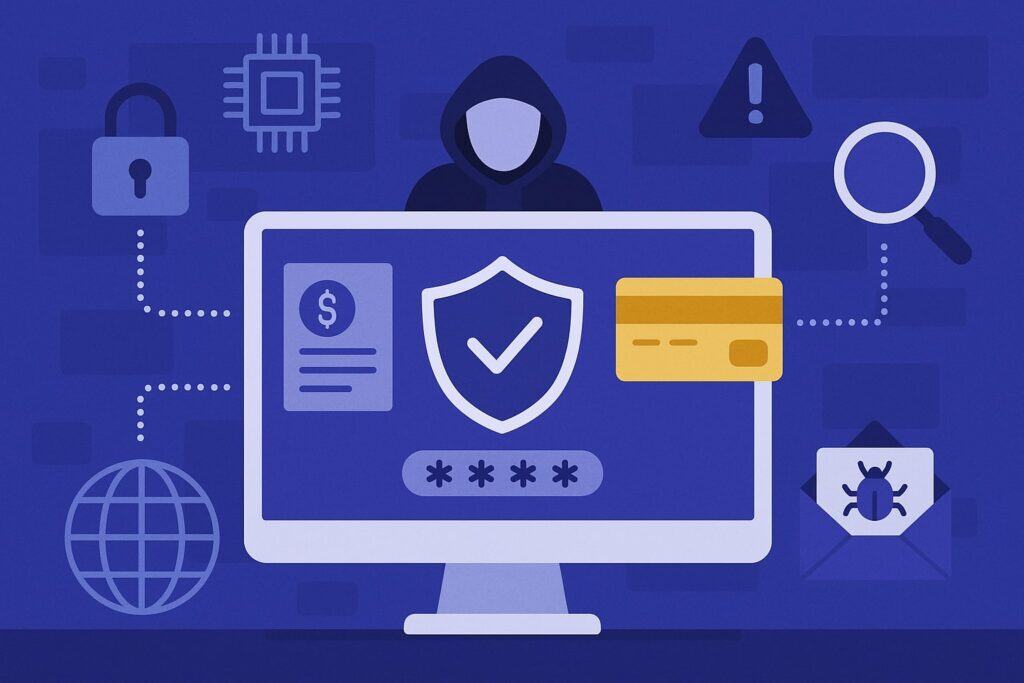
By crossborderfees October 11, 2025
In an era of global commerce and digital cross-border transfers, fraud prevention in international payments is more critical than ever. With evolving fraud techniques—such as synthetic identity schemes, deepfake impersonation, account takeover, and social engineering—organizations must adopt a multi-layered, proactive strategy to protect revenue, reputation, and compliance.
This article provides a comprehensive, updated guide (2025 perspective) on how to design, implement, and sustain effective fraud prevention in international payments. You will learn best practices, technical controls, regulatory considerations, and practical steps for different stakeholders (banks, fintechs, corporations, platforms).
Understanding the Risk Landscape of International Payment Fraud

Fraud prevention in international payments begins with a deep understanding of the threat landscape. Without knowing what kinds of fraud attacks are prevalent, you cannot build effective defenses.
Why International Payments Are Attractive to Fraudsters
Cross-border payments inherently have more friction, more participants (originator bank, correspondent banks, beneficiary bank, payment processor), currency conversions, variable trust, and regulatory differences. These factors create more weak links and ambiguity—which fraudsters exploit. For example:
- Less familiar counterparties or regions increase trust gaps.
- Multiple intermediaries make tracing and reversal harder.
- Differences in regulation and enforcement across jurisdictions reduce deterrents.
- Rapid payment rails (like instant or real-time cross-border systems) reduce the time for detection and intervention.
According to McKinsey, fraud in payments is expanding rapidly in sophistication, including synthetic identity fraud, deepfakes, account takeover, and real-time fraud.
In fact, new forms of fraud such as AI-generated identity spoofing, “fraud-as-a-service” tools, and coordinated fraud rings are growing threats. Thus, fraud prevention in international payments must be robust, adaptive, and multifaceted.
Common Types of International Payment Fraud
Here are key fraud types especially relevant across borders:
- Account Takeover (ATO): A fraudster obtains credentials (via phishing, malware, social engineering) and hijacks a legitimate account to initiate malicious transfers.
- Synthetic Identity Fraud: Combining fragments of real personal data with fictitious elements to create new identities that pass superficial checks, then using them to perpetrate transactions.
- Deepfake / AI Impersonation: Use of AI to generate fake voices, video, or documents to impersonate high-level executives or trusted individuals in payment instructions.
- Invoice / Supplier Fraud: Fraudsters infiltrate corporate accounts or email flows and modify supplier bank details to divert payments abroad (also called business email compromise, BEC).
- Social Engineering / Phishing: Scams in which employees or customers are tricked into authorizing fraudulent transactions.
- Money Laundering / Layering: Using international payment channels to layer or obfuscate illegal proceeds.
- Refund / Chargeback Fraud: After cross-border delivery, customers falsely dispute or claim non-delivery to recover funds.
- Ghost Payments / Mule Accounts: Fraud networks open mule accounts to accept and rapidly forward illicit funds across borders.
- Cross-border Real-time Payment Fraud: As low-latency cross-border rails proliferate, fraudsters exploit the narrow window before funds can be reversed.
Because these fraud types interact and evolve, fraud prevention in international payments must cover the entire lifecycle: onboarding, authentication, transaction monitoring, and post-payment investigation.
Key Principles and Strategy for Fraud Prevention in International Payments

To be effective, a fraud prevention program in the context of cross-border payments should be built on the following principles and strategic pillars.
Defense in Depth and Layering Controls
“Defense in depth” means not relying on a single control but layering multiple safeguards (technical, operational, procedural). For example:
- Strong identity verification (KYC) at onboarding
- Device profiling, behavior analytics, and risk scoring
- Real-time transaction risk screening
- Human review for high-risk flows
- Post-event audit and feedback loops
Because fraudsters adapt, the layers must be able to detect anomalies at multiple points, not just at the first gate.
Risk-Based Approach and Segmentation
Not all payments carry equal risk. Use a risk-based approach to segment payments by size, geography, counterparty trust level, currency corridors, and transaction type.
Higher-risk payments should be subject to more stringent checks (e.g. extra authentication, manual review). This reduces friction for low-risk payments while focusing controls where the threat is highest.
Use of Analytics, AI, and Behavioral Intelligence
Modern fraud prevention in international payments increasingly relies on machine learning, anomaly detection, graph analytics, behavioral profiling, and real-time scoring. These tools can detect subtle patterns invisible to traditional rules. McKinsey emphasizes that combining traditional and emerging approaches is essential to build resilient systems.
Recent academic advances, such as hybrid deep learning models combining RNNs, autoencoders, and transformers, have achieved high accuracy (98%+) in fraud detection. Also, graph neural networks (GNNs) have been applied to detect hidden relationships among accounts and uncover fraud rings.
Using such AI systems, especially in real time, strengthens defenses and helps flag novel fraud tactics.
Compliance, Regulatory Frameworks, and Transparency
Because international payments cross jurisdictions, compliance with global standards (e.g. AML, KYC, FATF, PSD2, data protection laws) is essential. For example, in 2025 the FATF revised Recommendation 16 (travel rule) to require standardization of information on cross-border payments above certain thresholds.
Banks and fintechs must also be ready for evolving reimbursement liability regimes: in many jurisdictions, institutions may be held accountable for fraud-related losses if they fail to implement proper controls.
Additionally, transparency in payment message information, audit trails, and reporting obligations are part of regulatory expectations.
Collaboration and Intelligence Sharing
No institution can see all fraud. Collaboration across banks, fintechs, payment networks, law enforcement, and industry consortia is critical. Sharing anonymized fraud signals, device fingerprints, blacklists, and threat intelligence helps improve detection. Cross-border consortia and global data sharing improve collective defenses.
In summary, fraud prevention in international payments must be strategic, layered, data-driven, compliant, and collaborative.
Technical Controls and Methods to Prevent Fraud in Cross-Border Payments

Here we dive into specific controls and technical approaches you can adopt as part of a fraud prevention framework.
Identity Verification and Know Your Customer (KYC)
Before transacting, verifying both payer and payee identities is foundational. In international payments, this is more challenging due to differing identity documents, languages, and reliability of registries. Best practices include:
- Use robust, multi-factor identity verification (document verification, biometric checks, live selfie, liveness detection)
- Cross-check government IDs, international passport, national databases
- Use external identity verification services / identity as a service (IDaaS) providers
- Validate address, phone number, tax identifiers, corporate registration documents (for business accounts)
- Use risk-based levels: for high-value payments require enhanced KYC
- Capture KYC data in structured, machine-readable form to feed risk systems
A robust onboarding KYC setup reduces the baseline fraud exposure in international payments.
Device, Browser, and Environment Profiling
Fraudsters often use new or compromised devices. Profiling the endpoint environment helps detect anomalies. Methods include:
- Device fingerprinting (OS, browser, plugins, fonts, hardware parameters)
- Mobile app ID, OS version, rooting/jailbreak detection
- Browser anomalies or remote access tools
- IP geolocation and consistency with user’s known locations
- Velocity checks (number of device changes, account changes)
If a transaction originates from a device never seen before or exhibits suspicious attributes, it should be flagged or require extra verification.
Behavioral and Transaction Monitoring / Risk Scoring
Continuous monitoring of user behavior and transaction patterns is key. Techniques include:
- Real-time scoring of each transaction (using machine learning models)
- Anomaly detection vs baseline behavior
- Graph analysis: detecting links to known fraudsters or suspicious accounts
- Velocity checks (number of transactions, frequency, amount escalation)
- Peer group comparisons (how similar users behave)
- Cross-correlation among related accounts to detect fraud rings
Any transaction scoring above a threshold can be escalated for manual review or additional authentication.
Multi-Factor Authentication (MFA) and Strong Customer Authentication (SCA)
For international payments, adding strong customer authentication is vital:
- Use MFA: combination of something you know (password), something you have (token, mobile app), and something you are (biometrics)
- Risk-based authentication: require more factors when risk is higher
- Use adaptive/re-authentication mid-session if risk changes
- In card payments, enforce SCA (e.g., 3D Secure v2.0 in European PSD2 jurisdiction)
- Leverage device binding so that users’ devices are recognized and lower friction for trusted devices
For example, India’s RBI guidelines (effective April 2026) allow risk-based additional authentication beyond traditional two-factor for non-recurring cross-border card-not-present payments.
Tokenization, Encryption, and Secure Messaging
Protecting sensitive payment data is essential to reduce exposure if systems are breached:
- Use tokenization: replace the actual card or bank account number with a token in systems
- End-to-end encryption of payment data in transit and at rest
- Use secure communication protocols (TLS, encrypted APIs)
- Message integrity checks and validation (e.g. cryptographic signatures)
- Isolate and limit data retention; do not store unnecessary PII or payment credentials
These controls reduce the “attack surface” for fraudsters.
Payment Message Verification and Information Integrity
Because cross-border payments involve many intermediaries, ensuring integrity of payment message fields (beneficiary name, IBAN, SWIFT/BIC, bank address, remittance information) is crucial:
- Enforce “name + account number matching” services in payment systems
- Use APIs or lookup services to verify bank codes, SWIFT routing accuracy
- Use structured remittance information fields (not free-text) to trace payment chain
- Monitor for “modified by intermediary” attacks (where a fraudster tampers with payment message in transit)
- Use cryptographic message validation to prevent tampering
The revisions in FATF Recommendation 16 (2025) emphasize standardized information accompanying cross-border payments to improve transparency and traceability, and require tools to verify recipient account data.
Real-Time Fraud Screening and Delay Controls
While many systems act post-facto, in international payments, real-time or near-real-time screening is essential:
- Use pre-authorization fraud rules and scoring
- Introduce short artificial delays (seconds to minutes) for high-risk payments to allow fraud checks
- For very high-risk transfers, require hold/review periods or manual confirmation
- Use dynamic rules (e.g. block payments crossing certain corridors above thresholds)
- Use “sanctions screening” or “watchlist screening” (donor lists, PEPs, high-risk regions)
These help intercept fraudulent payments before funds are irrevocable.
Manual Review, Investigation, and Case Management
Automated systems will flag only so much. A robust investigation and review process is necessary:
- Maintain a trained review team to analyze flags, request additional documentation, or call beneficiaries
- Use case management systems to track investigations, decisions, actions, and outcomes
- Use audit logs and evidence (device metadata, logs, communication history)
- Feedback loop: feed investigation outcomes back into machine learning models to improve future scoring
Manual review is critical for high-risk or high-value payments.
Reconciliation, Alerting, and Post-Event Analytics
After payment execution, fraud prevention must continue:
- Reconcile payments: compare expected payments vs executed flows
- Use exception alerting (unexpected beneficiaries, account changes, duplicate payments)
- Monitor refund/chargeback patterns
- Perform root cause analysis on fraud incidents
- Maintain dashboards, KPIs, and trend analysis
- Periodically reassess rules, thresholds, and models
This continuous improvement cycle strengthens fraud prevention in international payments over time.
Operational and Organizational Measures
Beyond technical controls, organizations must put in place processes and governance to sustain fraud prevention in international payments.
Governance, Policies, and Risk Framework
A clear governance structure is essential:
- Define ownership of fraud prevention (e.g. a Chief Fraud Officer / Head of Anti-Fraud)
- Establish policies for cross-border payment fraud management, escalation, liability, and response
- Use a fraud risk framework aligned to business objectives and risk appetite
- Regularly review and update policies in light of emerging threats
These ensure consistency, accountability, and responsiveness.
Segregation of Duties and Dual Approval
Operational controls prevent internal fraud:
- Require multiple individuals to approve or release large payments (dual control)
- Separate roles: transaction initiation, approval, validation, reconciliation
- Rotate staff and periodically audit payment teams
- Use “four eyes” principle especially for changes in beneficiary data
As the 2025 fraud best practices checklist suggests, dual control of payments significantly reduces risk.
Employee Training, Awareness & Culture
Employees are often the weakest link. To guard against social engineering, training is critical:
- Regular training on phishing, email scams, deepfake risks, impersonation
- Simulated phishing exercises and red-teaming
- Clear protocols for changes in supplier instructions (e.g. phone verification)
- Encourage a culture of “stop and verify” when instructions seem suspicious
- Reward internal reporting of anomalies without fear of reprisal
Strong organizational culture supports technical defenses.
Vendor, Partner, and Third-Party Risk Management
Third parties (payment processors, gateway providers, correspondent banks, fintech partners) introduce risk:
- Ensure partners comply with security, privacy, and fraud prevention standards
- Conduct due diligence, audits, and ongoing monitoring
- Require service-level agreements (SLAs) including fraud response obligations
- Ensure partners share relevant fraud signals and integrate with your risk systems
- Segregate responsibilities clearly (e.g. who is liable for what fraud losses)
Third parties must share accountability in fraud prevention in international payments.
Incident Response and Recovery Planning
Even the best defenses can be breached; you must be ready:
- Define incident response plans specific to payment fraud (containment, escalation, communication, forensic investigation)
- Prepare protocols for payment reversal, recall, or compensation (subject to jurisdictional and contractual constraints)
- Coordinate with law enforcement and regulatory authorities
- For cross-border fraud, liaise with correspondent and foreign banks for tracing
- After incident, review root causes, patch weaknesses, and update controls
This readiness limits damage and aids trust restoration.
Assurance, Audits and Testing
To ensure your fraud prevention in international payments continues to be effective:
- Conduct periodic internal and external audits of controls
- Perform red teaming, penetration testing, and fraud simulation
- Use “sandbox” or test environments to validate new models or rules
- Review control metrics, false positives/negatives, detection rates
- Adjust thresholds, retrain models, and refine policies
Such verification is essential in a changing fraud landscape.
Regulatory, Compliance, and Legal Considerations
Fraud prevention in international payments cannot be separated from regulatory and legal frameworks. Violations may lead to fines, reputational damage, or criminal liability.
AML, CTF, and International Sanctions
Cross-border transactions are high-risk for money laundering and terrorist financing. Financial institutions must adhere to:
- Anti-Money Laundering (AML) regulations (e.g., customer due diligence, transaction monitoring, suspicious activity reporting)
- Counter-Terrorist Financing (CTF) obligations
- Sanctions screening (OFAC, UN, EU, local) on parties, jurisdictions, and entities
- Politically Exposed Persons (PEP) filtering
Failure to embed these into fraud prevention systems invites regulatory penalties.
FATF and Recommendation 16 (Travel Rule)
The FATF update in 2025 to Recommendation 16 strengthens the information requirements on cross-border payments. Under the revised rules:
- Standardized payer and payee information (name, address, date of birth) must accompany cross-border transfers above certain thresholds
- Liability for including information is tied to the institution receiving instruction from the customer
- Institutions must use tools to verify recipient banking information to reduce error and fraud
Adhering to these standards is critical for compliance and fraud prevention.
Data Protection, Privacy, and Cross-Border Data Flows
Processing identity, transaction, and device data in fraud systems entails privacy and data protection regulations (e.g. GDPR, CCPA, local laws). Institutions must:
- Ensure lawful basis for data collection and processing
- Use data minimization and purpose limitation
- Secure data using encryption and anonymization where possible
- Respect cross-border data transfer rules (e.g. EU adequacy, SCCs)
- Allow subject rights (access, erasure) where applicable
These rules intersect with fraud analytics and system design.
Liability, Reimbursement and Consumer Protection
Regulators increasingly impose liability rules for fraud losses:
- Some jurisdictions require reimbursement to victims of authorized push payment (APP) scams or unauthorized cross-border transactions
- Banks or payment providers may be held liable if they fail to meet “reasonable” standards of security
- Clear contract terms with customers and third parties are essential
- Transparent dispute resolution, complaint handling, and compensation processes
Staying ahead of emerging regulatory regimes is part of fraud prevention in international payments.
Reporting Requirements and Audit Trails
When fraud or suspicious transactions are detected, institutions may be required to file Suspicious Activity Reports (SARs) or equivalents. Maintaining detailed audit trails is therefore critical:
- Keep logs of decision paths, system inputs, user actions
- Retain evidence for forensic analysis
- Report per regulatory timelines
- Coordinate across borders for cross-jurisdictional reporting
Good recordkeeping supports compliance, investigations, and defense against litigation.
Implementation Phases and Best Practices
A methodical rollout ensures that fraud prevention in international payments is implemented successfully and sustainably.
Phase 1: Assessment and Framework Design
- Conduct a fraud risk assessment across all cross-border payment corridors
- Map out payment flows, parties involved, data flows, weak points
- Define fraud risk appetite, thresholds, and segmentation
- Design the architecture: data pipelines, rule engines, machine learning models, interfaces
- Choose fraud analytics vendors or build in-house capability
Phase 2: Foundation Build and Pilot
- Deploy identity verification, device profiling, and basic rule engines
- Integrate tokenization, encryption, and secure messaging
- Build APIs to verify bank details, SWIFT routing, name matching
- Pilot with limited corridors, small volumes, or low-risk routes
- Collect signals, tune thresholds, monitor false positive/negative rates
Phase 3: Scaling and Integration
- Expand coverage to all corridors and transaction types
- Layer more advanced analytics (graph, anomaly detection, behavioral)
- Add real-time screening and delay controls
- Integrate with case management, audit, and manual review systems
- Extend to partner fintechs, gateways, and third parties
Phase 4: Monitoring, Feedback, and Adaptation
- Continuously monitor model performance, rule effectiveness
- Update models and rules based on fraud outcomes
- Conduct periodic stress tests, red teaming, scenario simulations
- Solicit feedback from operations, investigations, support teams
- Scale infrastructure and ensure low latency even under load
Best Practice Tips
- Begin with simple rule-based checks and build layer by layer
- Tune thresholds to balance false positives vs friction
- Prioritize high-risk corridors or currencies
- Use synthetic data and simulation to test edge cases
- Maintain a feedback loop between operations and analytics
- Use dashboards and alerts to monitor health of fraud systems
- Keep staff and executives informed of fraud trends and loss metrics
With phased implementation, you can progressively build robust fraud prevention in international payments without excessive disruption.
Challenges, Trade-offs and Emerging Trends
When deploying fraud prevention in international payments, you will face challenges and must manage trade-offs. Also, emerging trends must be watched.
Balancing Friction vs Security
A classic tension: stronger controls add friction and may reduce conversion or user satisfaction, especially in legitimate transactions. Overly aggressive blocking or authentication can frustrate customers. Risk-based approaches and adaptive authentication help calibrate friction.
False Positives & Customer Experience
Too many false alerts degrade merchant or user experience. Fine-tuning thresholds, using multiple signals, and human review are needed to avoid rejecting legitimate transactions. Monitoring false positive rates is critical.
Data Quality, Feature Availability, and Normalization
With global payments, data sources differ in format, completeness, and quality. Normalizing and cleansing data (e.g. mapping country codes, name formatting) is challenging. Missing values or inconsistent data reduce model accuracy.
Cold Start and Sparse Data in New Corridors
When expanding to new geographies, you may lack historical fraud data. Machine learning models may underperform. In such cases, rules, expert heuristics, transfer learning, or shared consortium data can help bridge gaps.
Latency and Scalability
Real-time scoring, graph analysis, and anomaly detection must operate at low latency even under high volume. Designing scalable pipelines and caching is essential, especially in high-throughput systems.
Adversarial Behavior and Model Drift
Fraudsters adapt tactics over time. Models degrade unless retrained. Ongoing monitoring for drift, retraining, and incorporation of new signals are mandatory. Attackers may attempt adversarial evasion, so models must be robust.
Deepfake and Synthetic Fraud Arms Race
The rise of AI and deepfake technology means fraud schemes will become more convincing. Institutions must deploy AI-based detection of deepfake identities and manipulated media. Academic work, e.g., GAN-based detection models for deepfake images in payments, offers promising direction.
Emerging frameworks combining LLMs and graph networks to detect fraud in e-commerce payments (within cross-border transactions) are being researched.
Staying ahead in this arms race requires continual innovation and investment.
FAQs
Q1: At what transaction threshold should fraud screening be applied?
Answer: There is no one-size-fits-all threshold. It depends on your risk appetite, payment volumes, and cost of false positives. A good approach is a tiered threshold system: basic screening for all, medium checks for mid-level amounts, and enhanced checks for high-value payments or new corridors.
Q2: How do we handle fraud prevention when there is no access to local identity databases?
Answer: In such cases, you can augment with third-party identity providers, document verification providers, global watchlists, consortium-shared data, or alternative signals (e.g. device, behavior, IP, historical patterns). Use cautious thresholds until enough data is collected.
Q3: How to reverse or recall a fraudulent cross-border payment?
Answer: Reversal depends on timing (before funds settle), correspondent bank cooperation, bilateral agreements, and legal frameworks. Your incident response policy should define protocols for recall requests, liaison with correspondent banks, and compensation. However, many systems minimize reversals; the better strategy is early detection and blocking.
Q4: How to manage fraud risk with multiple payment service providers (PSPs)?
Answer: Use a unified fraud orchestration or risk platform that aggregates signals across all PSPs. Enforce common rules, scoring, thresholds, and review logic. Ensure each PSP shares relevant telemetry and signal data for centralized fraud prevention in international payments.
Q5: How to measure the effectiveness of fraud prevention systems?
Answer: Common metrics include: fraud loss rate (fraud / total volume), false positive rate (legitimate blocked), acceptance rate, detection latency (time to detect), model precision/recall, operational costs per case, ROI. Periodically benchmark against industry standards (e.g. from fraud reports).
Q6: What legal jurisdiction applies in cross-border fraud disputes?
Answer: Jurisdiction depends on contractual terms, location of parties, and applicable laws. Contracts should specify governing law, dispute resolution mechanisms, and liability clauses. In practice, requiring arbitration or venue in a neutral jurisdiction is common.
Conclusion
Fraud prevention in international payments is complex and ever-evolving, but essential in modern global finance. With the rising sophistication of fraud—driven by AI, synthetic identity schemes, and real-time rails—organizations must adopt a well-architected, layered, and adaptive approach.
The key is combining robust technical controls (identity verification, behavior analytics, real-time screening, tokenization), operational measures (segregation of duties, training, manual review), and regulatory compliance (AML, FATF, data protection) in a unified strategy.
Success demands a risk-based framework, ongoing monitoring, feedback loops, and close collaboration across financial institutions and jurisdictions.
Emerging technologies like graph analytics, AI, hybrid models, and consortium data sharing can significantly improve detection capabilities. But organizations must balance security with customer experience, constantly recalibrate thresholds, and stay ahead of fraudsters’ tactics.
By following the principles, controls, and best practices laid out in this guide, you can build a resilient system to handle fraud prevention in international payments.
If you’d like help designing a fraud architecture, evaluating vendors, or customizing for your region or industry, I’d be glad to assist further.